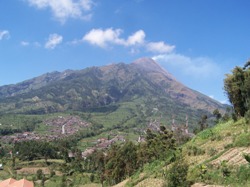
“OUR VILLAGE IS SAFE”
With so many killed last year, including Mbah Maridjan, will similar myths arise, as residents return to their stricken settlements? The answer may relate to the widespread perception that ‘our village is safe’.
This idea comes not only from a belief in the supernatural creatures’ ability to protect certain dutiful settlements but also from previous eruption experience. On the northen saddle between Mt Merapi and Mt Merbabu ( a volcano immediately north of Merapi – cover image) communities clinging to the unstable slopes have not been directly affected by an eruption in living memory. Farmers here find it unimaginable that Mt Merapi could erupt in their direction - and therefore have no plans to evacuate. Harno, a resident of Bulu Kidul on the north east of the volcano, says:
“It is impossible for Merapi to spit here, this is the back bone. We have never evacuated from here. It is impossible...”
As Harno implies, the volcano is thought in this region to be a giant sitting with its back to the northern villages. The erupting volcano is thought to be vomiting; and because vomit comes only from the mouth, the belief is that Mt Merapi too will only spew southwards. As Ismail, from Selo (the largest settlement on Mt Merapi’s southern flank) says:
“If you climb Merapi from the south the Sultan says that it is dangerous and impolite because you are climbing up the face of Merapi”
With such a strong conviction that their villages are safe, many locals on Mt Merapi do not believe that evacuation is necessary, especially when this means abandoning their livestock and potentially losing all they have. For these extremely poor communities their livestock are their livelihoods, savings and future. As Narti from Pelemsari explains:
“If I stayed in the evacuation place I get food but my cow does not”
These people have to balance the risk between definitely losing their income if their livestock starve, or possibly losing everything in an eruption. In 2006, many villagers were unwilling to accept the loss of their livestock and continued to care for them throughout the crisis. This meant that communities at risk only evacuated part-time, returning home during daylight hours. Similarly, in the initial stages of the 2010 eruption, the local population tried to return to their homes. Sadly this risk became too great. Pelemsari was one of the first settlements to be destroyed as pyroclastic flows thundered down the once-lush slopes.